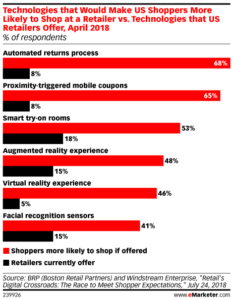From rural strip malls across the country to Fifth Avenue, it has been a disastrous time for retail in the US. J.C. Penney, Sears, Payless, Gap, H.H Gregg, Gymboree, Bebe, RadioShack (and many more) each announced 100+ store closures in 2017. 2018 appears to be even worse with mall vacancies hitting a six-year high and more than 12,000 stores expected to close.
The current retail apocalypse is even more astounding when you consider the current US business climate: strong economic expansion, low unemployment and high consumer confidence. While Amazon is often tagged as the bogeyman responsible for the downfall of retail, the full story is more complicated. It involves shifting consumer preferences and the impact of private equity in the market.
Does the future hold more stormy weather or are rainbows in the forecast?
Retailers are starting to wake up and respond to opportunities that digital transformation offers to help reinvigorate their industry. In 2017, just 9% of retailers cited data-driven marketing as the most exciting opportunity for the year ahead. This number doubled to 19% (compared to 16% across all sectors) in Adobe’s 2018 Digital Trends in Retail report. Clearly many retailers are starting to realize how data-driven strategies can set them apart from the competition and improve the bottom line.

Retailers will need to move fast to meet consumer expectations. A recent study in eMarketer found that many consumers would be more likely to shop at a retailer that offered technology capabilities like smart try-on rooms, as well as augmented reality and geo-triggered coupons. But while interest is there—and retailers are aware of the impact it could have if offered—a good number of them don’t offer such capabilities yet. For instance, 68% of consumers want an automated returns process, but only 8% of retailers offer the service.
Retailers that have weathered the transition to a digital era (such as Kohl’s, Five Below and b8ta) have embraced technology and employed omnichannel strategies. An omnichannel retail strategy treats every channel that the retailer is present on – its physical stores, catalogues and directories, digital presence across different devices, social media, and any other online or offline outlets – as one, seamless experience. Omnichannel retail acknowledges and harnesses the reality that customers shop across a whole range of different channels, often starting their customer journey on one channel and completing it on another.
A recipe for retailers who want to survive the looming apocalypse is not overly complicated: embrace technology, deliver a superior customer experience and adopt an omnichannel strategy. As with all innovation programs, the key is to think big, start small and move fast. Opportunities abound for those with the vision and courage to seize them.

